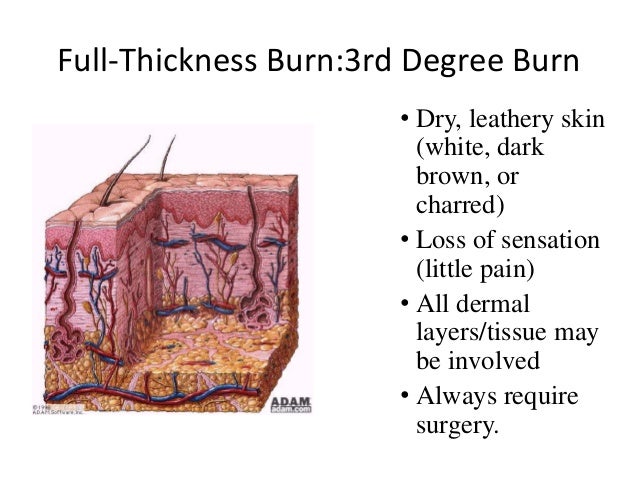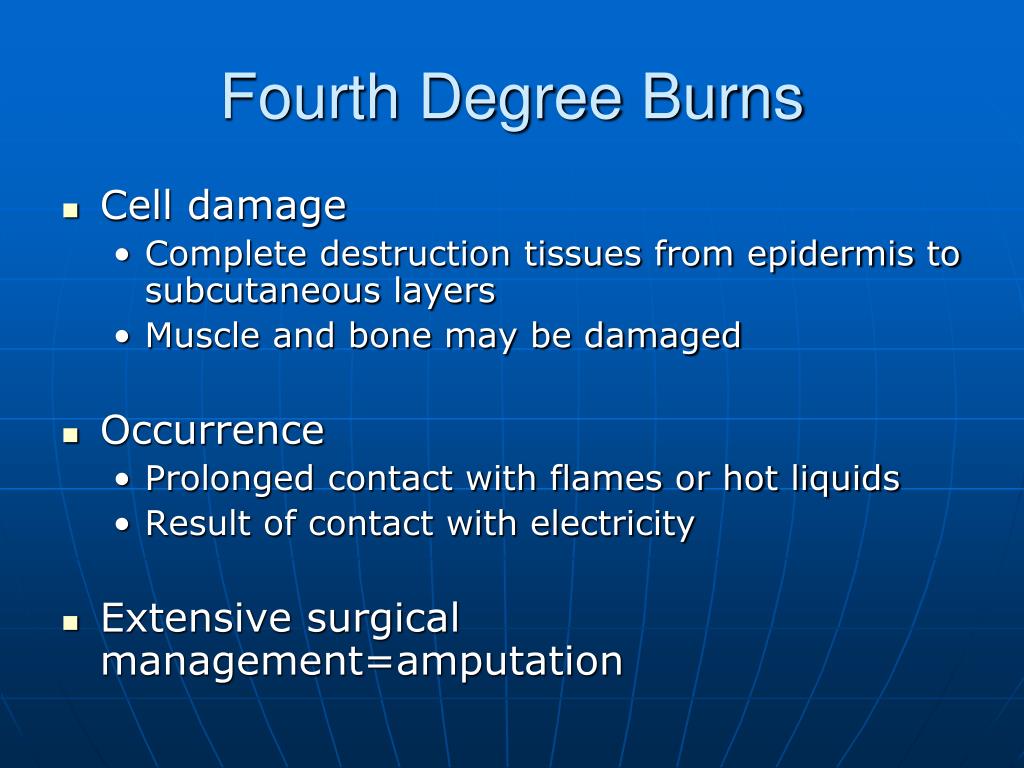

Epidermis, dermis, and deeper structures (muscles, fat, fascia, and bones).
4th degree burn symptoms skin#
Tissue necrosis with black, waxy-white, or gray leather-like skin ( eschar ).No (perception of deep pressure is intact).Epidermis, dermis, and subcutaneous tissue.Mottled coloration of the skin with red and/or white patches.

Vesicles/ bullae: fragile (rupture easily).Yes ( pain is typically felt on applying pressure).Deeper layers of the dermis ( papillary and reticular dermis).Temporary hypopigmentation/ hyperpigmentation.Yes (especially with the movement of air or changes in temperature in the area surrounding the wound).Epidermis and upper layers of the dermis ( papillary dermis).ClassificationĢ nd-degree burn ( partial thickness burn)Ģa ( superficial partial thickness burn ) at high speeds) and the heat generated by the resulting friction (e.g., from skidding across the street due to a motorcycle accident)Īlthough most burn injuries are unintentional, intentional injury must always be suspected in vulnerable populations, such as children and older adults. Friction burns : skin injury caused by abrasion against a hard surface (esp.High-energy particles (e.g., from radiotherapy, nuclear accidents): alpha particles, beta particles, high-energy neutrons.Infrared waves (e.g., from warming lamps), microwaves.X-rays, gamma rays (e.g., from radiotherapy, radiodiagnostic procedures, nuclear accidents).UV radiation (e.g., from sunlight, phototherapy).High-voltage sources: power lines, lightning.Low-voltage sources: electrical cords, outlets in households.Miscellaneous: white phosphorus (e.g., in fireworks), metals (e.g., sodium, potassium, lithium), bleaching agents (e.g., hydrogen peroxide, hypochlorite), vesicants (e.g., mustard gas), hydrocarbons (e.g., gasoline, diesel fuel).Alkalis such as anhydrous ammonia (e.g., in fertilizers), calcium oxide (e.g., in cement), sodium hydroxide, and potassium hydroxide.Acids such as sulfuric acid (e.g., in lead acid batteries), nitric acid (e.g., explosives and polymer industry), hydrofluoric acid (e.g., in cleaning products for electronics), phenol, and acetic acid.The most common causes of death due to burns are shock, sepsis, and respiratory failure. Burn wounds easily become infected, and large, severe burns are often fatal. Treatment of third- and fourth-degree burns involves debridement of necrotic tissue followed by skin graft or a tissue transfer via flap reconstruction. First- and second-degree burns can be treated with antiseptic ointment and dressings. Escharotomy should be performed to treat compartment syndrome and prevent acute limb ischemia. In circumferential burns around limbs, peripheral pulses and capillary refill can be used to assess perfusion. Blood oxygen, arterial blood gas, electrolyte, and creatinine levels should be monitored closely in patients with third- and fourth-degree burns.

Various formulas exist to calculate initial fluid requirement, but fluids should be adjusted to maintain clinical stability and appropriate urine output. Patients with severe burns may require intubation, supplemental oxygen, and resuscitation with IV fluids. Massive tissue necrosis, which occurs with severe burns, may result in sepsis, shock, and sequential organ failure (see “ SOFA score” for details). The TBSA is calculated using Lund-Browder charts. The current classification of burns is based on burn depth and recognizes four degrees: first degree ( superficial), second degree ( superficial partial-thickness and deep partial-thickness), third degree (full-thickness), and fourth degree (deeper-injury burn). The two factors that influence the severity of a burn are its depth and the total body surface area ( TBSA) involved. Burns are injuries to tissue caused by heat, chemicals, electricity, friction, and/or radiation.


 0 kommentar(er)
0 kommentar(er)
